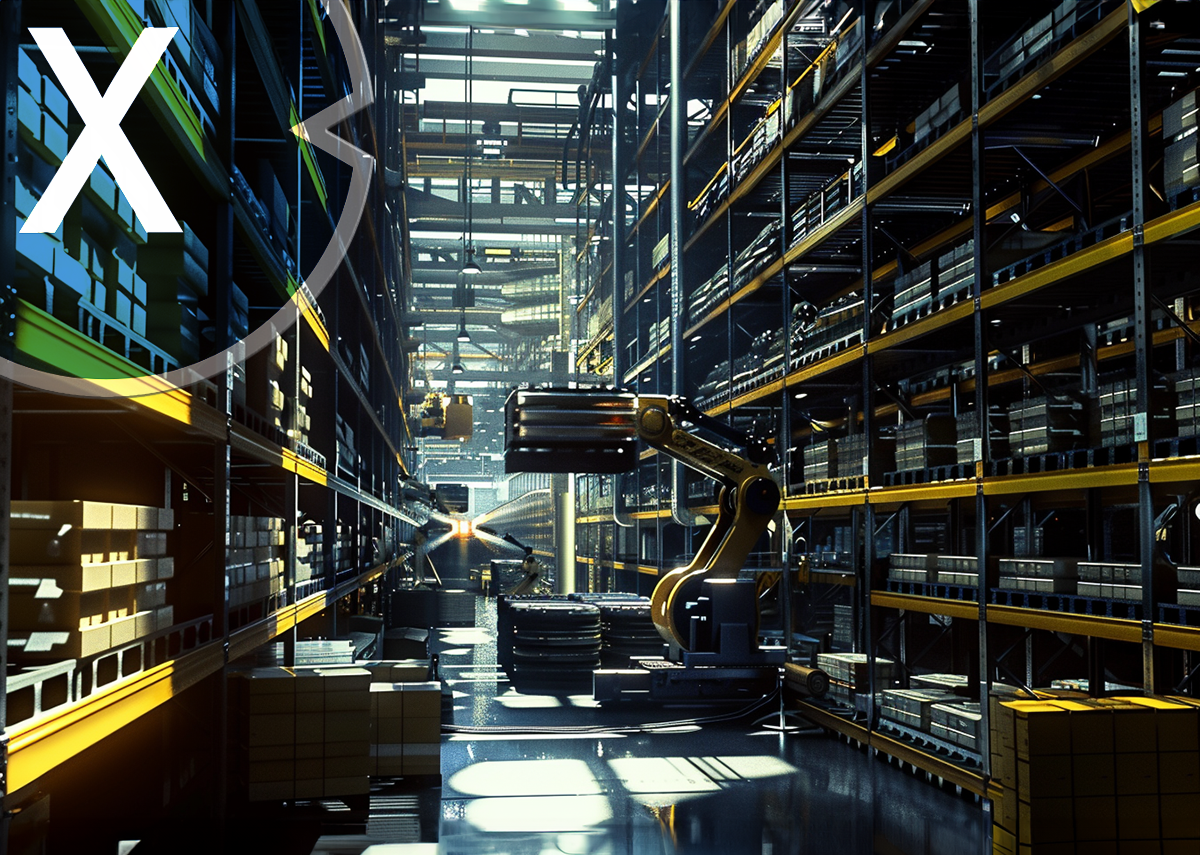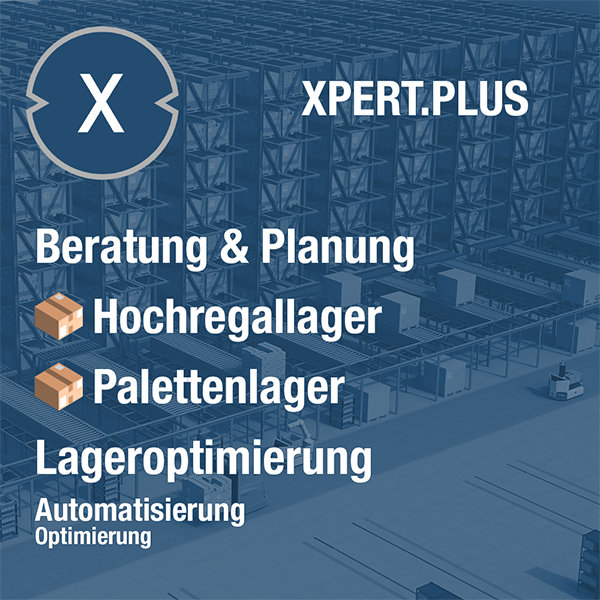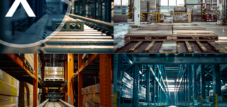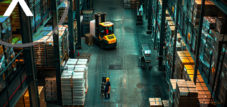Fully automated & innovative storage concepts – Logistics 4.0: Automated and remote-controlled pallet high-bay warehouses
Language selection 📢
Published on: September 27, 2024 / Update from: September 27, 2024 - Author: Konrad Wolfenstein

Fully automated and innovative storage concepts – Logistics 4.0: The remote-controlled revolution of pallet high-bay warehouses – Image: Xpert.Digital
🏭🔧 Logistics 4.0: Remotely controllable high-bay warehouses and their advantages
⏩⚙️ Transformation of logistics: increasing efficiency through automation
A remarkable transformation is emerging in the rapidly evolving world of logistics and warehousing. The era of Logistics 4.0 is bringing about groundbreaking innovations that are fundamentally changing the way we store, manage and transport goods. At the heart of this revolution are fully automated and remote-controlled pallet high-bay warehouses that not only increase efficiency, but also set new standards in terms of precision, speed and cost efficiency.
🔄 The further development of warehousing
The history of warehousing goes back a long way and has gone through numerous stages of development over the centuries. From simple warehouses where goods were manually stacked and sorted to the first mechanized systems of the 20th century, the journey was long and often arduous. However, with the advent of digitalization and automation over the past few decades, the pace of innovation has accelerated dramatically.
🧰 From manual processes to partial automation
In the early days of industrial warehousing, manual processes were the norm. Workers moved goods using muscle power, supported by simple tools such as handcarts or hand trucks. The introduction of forklifts in the 1920s marked a first major step towards mechanization. This innovation made it possible to move heavier loads and stack goods higher, significantly improving the use of space in warehouses.
Over time, the camps became more and more complex. The introduction of conveyor belts and the first automated sorting systems in the 1960s and 1970s heralded the age of partial automation. These systems made it possible to move goods through the warehouse more quickly and efficiently, but did not yet significantly reduce the need for human labor for many core tasks.
🌐 The leap to full automation
With the advent of powerful computers and advanced robotic technology in the 1980s and 1990s, the era of full automation in warehousing began. Automated storage and retrieval machines, computer-controlled conveyor systems and the first attempts with autonomous vehicles in the warehouse marked the beginning of a new era.
This development ultimately led to the state-of-the-art, fully automated pallet high-bay warehouses we know today. These systems integrate advanced sensor technology, artificial intelligence and precise control systems to create a virtually deserted warehouse environment where goods are handled with the highest efficiency and accuracy.
🔑 Core components of modern pallet high-bay warehouses
Today's fully automated pallet high-bay warehouses are complex systems consisting of several key components. Each of these components contributes to optimizing the overall efficiency and performance of the warehouse.
🤖 Automated storage and retrieval machines (RBG)
The heart of a modern high-bay warehouse is the automated storage and retrieval machines. These highly specialized machines move along the rack aisles and are responsible for loading and unloading the pallets. Equipped with precise sensors and control systems, they can place and remove pallets with millimeter precision.
Modern RBGs are capable of reaching heights of over 40 meters and can reach speeds of up to 5 meters per second. Your efficiency is further increased by advanced algorithms that calculate optimal routes and evenly distribute the workload.
🚚 Conveyor technology and transfer stations
A sophisticated network of conveyor belts, roller conveyors and chain conveyors connects the various areas of the warehouse. This conveyor technology transports the pallets from incoming goods to the storage and retrieval machines and from there to outgoing goods or to picking stations.
Transfer stations form the interface between the conveyor technology and the storage and retrieval machines. Here the pallets are precisely aligned and prepared for storage or made available for further transport after removal from storage.
🧠 Warehouse management systems (Warehouse Management System – WMS)
The brain of the entire system is the warehouse control system. This highly complex software coordinates all processes in the warehouse, from the allocation of storage locations to the control of the storage and retrieval machines to the optimization of picking processes.
Modern WMS use artificial intelligence and machine learning to continuously optimize warehouse operations. They analyze data in real time to identify shortages, improve utilization, and forecast future inventory needs.
📡 Identification and tracking systems
In order to keep track of the inventory and the position of each individual pallet at all times, advanced identification and tracking systems are used. RFID tags (Radio-Frequency Identification) or barcode labels on the pallets enable complete tracking of every movement in the warehouse.
These systems are supplemented by a network of sensors and cameras that monitor the condition of the goods and can identify potential problems at an early stage.
💼 Advantages of fully automated pallet high-bay warehouses
Implementing fully automated solutions brings a variety of benefits that go far beyond the obvious reduction in staffing requirements.
⚡ Increased efficiency and productivity
Automated systems work around the clock without any signs of fatigue. You can move goods in and out faster than would be possible with manual methods. Precise control and optimized route planning minimize empty runs and maximize system utilization.
✅ Improved accuracy and reduced error rate
Human errors during storage and retrieval or picking are almost eliminated by automation. The exact positioning of the pallets and the complete digital recording of all movements ensure unparalleled accuracy in inventory management.
🏗️ Optimized use of space
Automated high-bay warehouses can be built significantly higher and narrower than conventional warehouses. The precise control of the storage and retrieval machines enables minimal distances between the rows of shelves, which leads to maximum utilization of the available space.
🛡️ Increased security
In fully automated warehouses, people only move in clearly defined areas. This drastically reduces the risk of accidents at work. In addition, dangerous or sensitive goods can be stored in locked areas that can only be accessed by authorized persons.
🌱 Improved energy efficiency
Modern automated storage systems are often more energy efficient than traditional warehouses. LED lighting that is only activated when needed, energy recovery when the storage and retrieval machines brake and optimized air conditioning help reduce energy consumption.
🧩 Challenges and solutions
Despite the many advantages, companies face some challenges when implementing fully automated pallet high-bay warehouses.
💰 High initial investment
The construction of a fully automated high-bay warehouse requires considerable financial resources. The costs for the hardware, software and the necessary infrastructure can run into the millions. Companies must carefully consider whether this investment will be worthwhile in the long term.
Solution approach
Many providers now offer flexible financing models, including leasing options or pay-per-use models. Companies can also introduce automation gradually to spread costs over a longer period of time.
🛠️ Complexity of systems
The complexity of fully automated storage systems places high demands on the technical know-how of the operator. Failures or malfunctions can have serious consequences and paralyze the entire operation.
Solution approach
Comprehensive staff training programs, preventive maintenance strategies and redundant systems can increase reliability. Many manufacturers also offer 24/7 support and remote diagnostic options.
🔌 Integration into existing systems
Seamlessly integrating a fully automated high-bay warehouse into existing IT infrastructures and business processes can be a challenge.
Solution approach
A careful planning phase involving all relevant departments is essential. Modern storage systems have open interfaces that make integration into existing ERP systems easier.
🔭 Future prospects and trends
Developments in the area of automated pallet high-bay warehouses are progressing continuously. Some of the most exciting trends and future prospects are:
🧠 Integration of artificial intelligence and machine learning
AI systems are increasingly being used to optimize warehouse operations, predict maintenance needs and improve inventory planning. Machine learning algorithms can learn from historical data and thus continuously increase the efficiency of the warehouse.
🚜 Use of autonomous vehicles
In addition to the classic storage and retrieval machines, autonomous vehicles are increasingly being used that can operate flexibly in different areas of the warehouse. These vehicles can orient themselves independently and avoid obstacles, which increases the flexibility of the storage system.
🥽 Augmented reality for maintenance and training
AR technology is used to support maintenance work and train employees. Technicians can be guided through AR glasses that show them information and instructions in real time.
🌿 Sustainability and energy efficiency
The trend towards greater sustainability will drive the development of more energy-efficient systems. Solar panels on warehouse roofs, innovative insulation techniques and even more efficient drive systems will help reduce the ecological footprint of logistics centers.
📦 Integration into the supply chain
Fully automated high-bay warehouses are increasingly viewed as an integral part of the entire supply chain. The seamless networking with suppliers, production sites and customers enables even more precise planning and control of the flow of goods.
### 🏁 The pinnacle of technological development in modern logistics
Fully automated and remotely controllable pallet high-bay warehouses represent the pinnacle of technological development in modern logistics. They offer companies the opportunity to dramatically increase their warehouse efficiency and reduce costs while improving the accuracy and reliability of their warehouse processes.
Although the implementation of such systems represents a significant investment and involves technical and organizational challenges, the long-term benefits in many cases clearly outweigh them. As technology advances and AI and IoT technologies become more integrated, these systems will become even more powerful and flexible.
For companies that want to survive in a highly competitive global market, fully automated warehouse solutions are increasingly moving from an optional competitive advantage to a necessary prerequisite for business success. Logistics 4.0 is not just a vision for the future, but is already a reality in many progressive companies worldwide.
The continued development of these technologies promises to continue to push the boundaries of what is possible in warehousing and logistics. Companies that follow these developments closely and invest in future-oriented technologies in a timely manner will be well positioned to master the challenges of the future and strengthen their position in the market.
📣 Similar topics
- 🚀 The transformation of warehousing: Logistics 4.0 and fully automated high-bay warehouses
- 📦 Evolution of warehousing: From manual processes to automation
- 🤖 Fully automated warehouse: The advantages of modern pallet high-bay warehouses
- 🏭 Automated storage and retrieval machines: The heart of the modern warehouse
- 📈 Increased efficiency through conveyor technology and transfer stations
- 💻 Warehouse control systems: The intelligence behind automated high-bay warehouses
- 🔍 Tracking and identification: RFID and sensors in use
- ⚡ Energy efficiency and sustainability in modern warehouses
- 💡 Future prospects: Artificial intelligence and autonomous vehicles in the warehouse
- 🌍 Integration into the supply chain: The networked warehousing of the future
#️⃣ Hashtags: #Warehousing #Automation #Logistics #AI #Efficiency
Xpert partner in warehouse planning and construction
📦🤖 Automated high-bay warehouses: An overview
✳️ Automated pallet high-bay warehouses are an integral part of this development. These are warehouses in which pallets are stored on racks at great heights - often up to 40 meters high. What makes these warehouses so innovative is the use of automated storage and retrieval machines, conveyor technology and IT systems that enable precise control and monitoring of the warehouse processes.
In a fully automated high-bay warehouse, the entire process of storing and retrieving goods is carried out without human intervention. Instead of employees operating forklifts, machines take on the task of bringing pallets to their storage location or picking them up. These machines, often called stacker cranes or automatic conveyors, move autonomously through the warehouse and access goods stored in pre-defined areas. The use of robots and sophisticated sensors ensures that these processes are carried out with the highest precision.
A central element in these automated warehouses is control via so-called warehouse management systems (WMS). These software solutions coordinate the various machines, monitor inventories and optimize warehouse processes in real time. This allows warehouse operators to ensure that the right goods are always available at the right time, resulting in a significant improvement in delivery speed and accuracy.
📈✨ Advantages of automation in warehousing
The use of fully automated warehouse technologies offers companies a variety of advantages. The most important include:
1. Increased efficiency
By using automation technologies, companies can significantly speed up their warehouse processes. Machines work around the clock, without breaks, and can therefore achieve significantly higher productivity than human employees. In addition, human errors that often occur in manual processes are eliminated.
2. Space optimization
Automated high-bay warehouses enable vertical storage of pallets, making optimal use of the available space in a warehouse. Thanks to the precision of the machines, shelves can be built denser and higher, resulting in significant space savings.
3. Cost reduction
While implementing a fully automated warehouse involves a large initial investment, these costs are recouped through the long-term savings. Automation reduces the need for labor and minimizes the cost of errors, which can reduce operational costs.
4. Improved security
Automated systems reduce the risk of workplace accidents because dangerous tasks, such as lifting heavy loads or working at great heights, are carried out by machines. Sensors and safety systems also ensure that machines can be switched off immediately in emergency situations.
5. Sustainability
Modern automated storage concepts also place great emphasis on energy efficiency. The machines are often designed in such a way that they use as little energy as possible while at the same time using waste heat or using renewable energy. This not only helps reduce operating costs, but also improves the company's environmental footprint.
🖥️📶 The role of remote control and digitalization
An essential component of modern logistics systems is the ability to remotely control and monitor processes. Using advanced IT systems and digital platforms, warehouse managers can access warehouse processes at any time and from anywhere and control them in real time. With the help of cloud-based solutions and the use of the Internet of Things (IoT), all warehouse activities are continuously recorded and analyzed. This allows companies to react more quickly to changing market requirements or unforeseen events.
The digitalization of warehouse processes also makes more precise forecasts and planning possible. Modern systems use big data analytics to create inventory forecasts, anticipate changes in demand and optimize supply chains accordingly. This leads to increased flexibility and better adaptability in an increasingly complex and dynamic market environment.
⚙️🛠️ Challenges of automation
Despite the many advantages that automated pallet high-bay warehouses offer, there are also challenges that cannot be ignored. Implementing such systems requires significant investments in technology, infrastructure and expertise. Small and medium-sized companies (SMEs) in particular often have difficulty meeting the high costs of introducing and operating these technologies.
In addition, the transition from manual to fully automated processes is a significant change for many companies. This requires not only technological adjustments, but also changes in the organizational structure and corporate culture. Employees will need to be properly trained to work with the new systems and there may be resistance, particularly if there are fears that automation will result in job losses.
Another risk is dependence on technology. In the event of a system failure or technical problems, significant operational disruptions can occur. Therefore, companies need to ensure that they have robust backup systems and maintenance plans in place to keep the automated systems running smoothly.
🌐🔮 Future prospects: Where are we headed?
The automation of pallet high-bay warehouses is just the beginning of a broader transformation of the logistics industry. In the future, the use of artificial intelligence (AI) and machine learning (ML) will play an even more central role. These technologies will enable automated warehouse systems to not only work more efficiently, but also to be self-learning and continually improve.
Additionally, the integration of robotics and drone technology into warehouses is expected to continue to increase. Some companies are already experimenting with drones for inventory monitoring and robots that autonomously carry out small deliveries within the warehouse. These developments have the potential to further increase warehousing efficiency and further reduce operating costs.
The increasing networking of warehouses with the other links in the supply chain will also be a decisive factor. By seamlessly integrating suppliers, manufacturers and distributors into a common digital network, warehouse processes can be made even more precise and efficient.
🏁📊 Remote-controlled pallet high-bay warehouses represent an important milestone in the development of modern logistics
Automated and remotely controllable pallet high-bay warehouses represent an important milestone in the development of modern logistics. They offer companies the opportunity to make their warehousing more efficient, cost-effective and safer while improving flexibility and responsiveness to market changes. Despite the challenges associated with adopting these technologies, the long-term benefits are undeniable.
The future of warehousing will undoubtedly be characterized even more by automation, digitalization and networking. Companies that adapt these trends early on will be able to assert themselves successfully in an increasingly competitive market environment and sustainably strengthen their position.
📣 Similar topics
- 🚀 Automated high-bay warehouses: An overview
- 🏗️ Innovation in pallet high-bay warehouses
- 🤖 Machines take over: The complete storage process
- 📡 Warehouse management systems: The invisible directors
- 📈 Benefits of automation: Increase efficiency and productivity
- 🧩 Space optimization through vertical storage
- 💰 Cost reduction through automated technology
- 🛡️ Safety in the workplace through automation
- 🌱 Sustainability in modern storage concepts
- 🌐 Digitalization and remote control in logistics
#️⃣ Hashtags: #automation #warehousing #efficiency #digitalization #sustainability

Xpert.Plus warehouse optimization - high-bay warehouses such as pallet warehouses consulting and planning
We are there for you - advice - planning - implementation - project management
☑️ Smart City & Factory: Industry expert for energetic 5G buildings and halls as well as advice and installation of solar systems
☑️ Xpert.Plus - logistics consulting and logistics optimization
☑️ Industry expert, here with his own Xpert.Digital Industry Hub with over 2,500 specialist articles
I would be happy to serve as your personal advisor.
You can contact me by filling out the contact form below or simply call me on +49 89 89 674 804 (Munich) .
I'm looking forward to our joint project.
Xpert.Digital - Konrad Wolfenstein
Xpert.Digital is a hub for industry with a focus on digitalization, mechanical engineering, logistics/intralogistics and photovoltaics.
With our 360° business development solution, we support well-known companies from new business to after sales.
Market intelligence, smarketing, marketing automation, content development, PR, mail campaigns, personalized social media and lead nurturing are part of our digital tools.
You can find out more at: www.xpert.digital - www.xpert.solar - www.xpert.plus


























